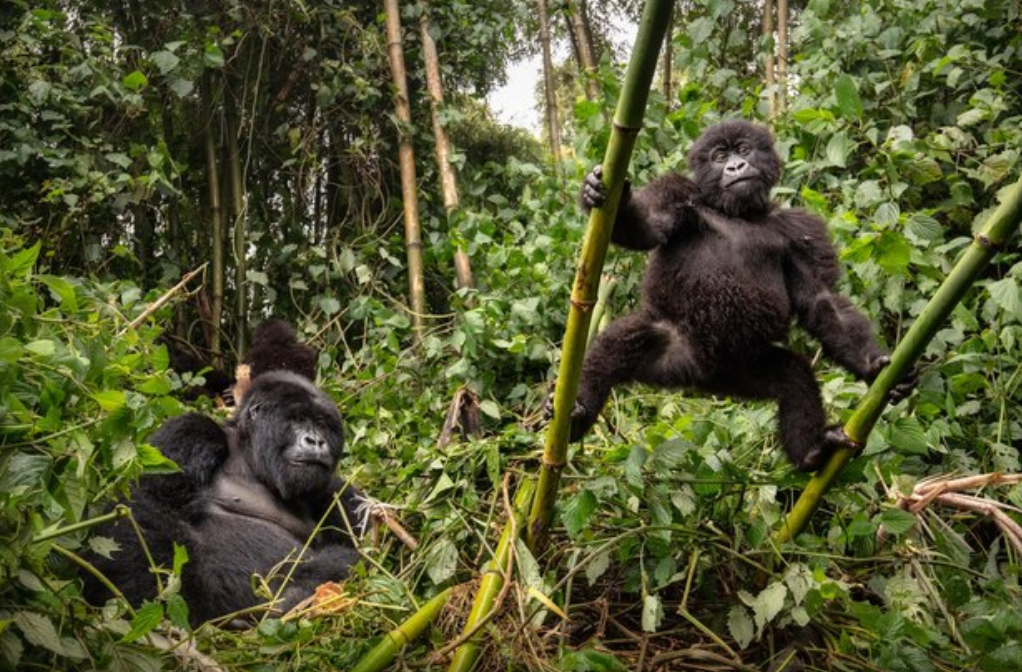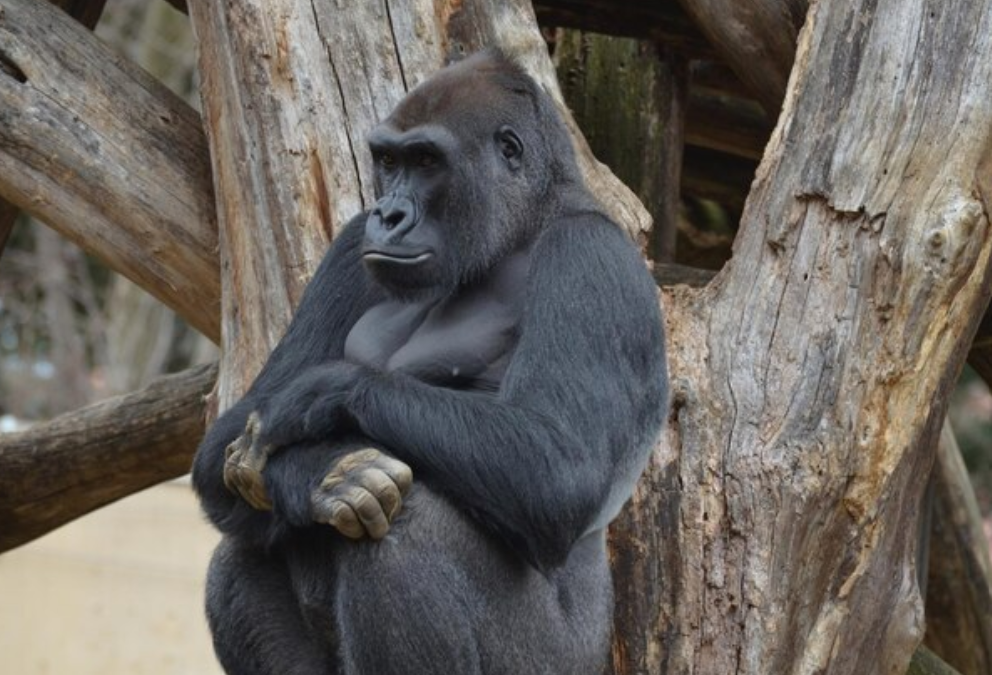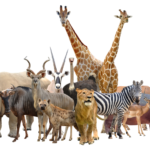Classification of gorillas as primates and their place in the animal kingdom
Originating from central Africa’s woodlands, gorillas are amazing animals. They are the biggest primates on the planet and are renowned for their extraordinary intellect and power. As herbivores, gorillas mostly consume fruits, leaves, and stems. They are also gregarious animals that inhabit troops, which may have as many as thirty members. More facts about gorillas are:
Top 10 Facts About Gorillas
| SCIENTIFIC NAME | Gorilla gorilla (Gorilla) |
| CLASSIFICATION | KINGDOM: Animalia CLASS: Mammalia ORDER: Primates FAMILY: Hominidae PHYLUM: Chordata GENUS: Gorilla |
| SIZE | Height: 1.4 to 1.8 meters (4.6 to 5.9 feet) for males Weight: 140 to 180 kg (310 to 400 lbs) for males, 70 to 100 kg (150 to 220 lbs) for females |
| HABITAT | Forests and mountains in central Africa (Gabon, Congo, Rwanda, Uganda, and Democratic Republic of the Congo) |
| DIET | Herbivorous – Primarily feeds on fruit, leaves, stems, and bamboo |
| SPECIES | Gorilla (*Gorilla gorilla*) |
| COUNTRY | Central Africa, including countries like Rwanda, Uganda, Gabon, and the Democratic Republic of the Congo |
| GESTATION PERIOD | Approximately 8.5 months (257 days) |
| LIFE SPAN | Up to 35-40 years in the wild, and potentially longer in captivity |
| CONSERVATION STATUS | Endangered – Threatened by habitat loss, poaching, and diseases like the Ebola virus |
Different species of gorillas and the conservation status of gorillas
There are two species of gorillas: the eastern and western gorillas. The mountain gorilla and the eastern lowland gorilla are the two subspecies that make up the eastern gorilla. The western lowland gorilla and the Cross River gorilla are the two subspecies of the western gorilla. Regrettably, poaching, sickness, and habitat degradation have rendered all four gorilla subspecies endangered.
Observations of gorillas in the wild have shown them to be clever animals that use tools. Additionally, they have been seen using a range of body language, facial expressions, and vocalisations to interact with one another. Gorillas are also capable of feeling a variety of emotions, such as happiness, sorrow, and rage. Gorillas are powerful and large animals, yet they are typically placid creatures who only turn hostile when provoked or threatened.
Fascinating facts about gorillas in the animal kingdom
Among the most recognisable and adored primates on earth are gorillas. In reality, these intriguing animals belong to the Hominidae family, which also includes humans and other apes. These fascinating details regarding these ancestors of primates are as follows:
1. The biggest living primate is the gorilla. A mature male may weigh more than 180 kg and grow to a height of 1.8 m.
2. Alpha males lead tiny family groups of gorillas. If men are unable to form their own group, they may lead extremely isolated lives.
3. The western gorilla (Gorilla gorilla) and the eastern gorilla (Gorilla beringei) are the two primary species of gorillas. The eastern gorilla is further subdivided into mountain gorillas and eastern lowland gorillas, whereas the western gorilla is further separated into western lowland gorillas and cross-river gorillas.
4. Fruits, tree bark, leaves, and shoots are the principal foods that gorillas eat. In addition, they may consume termites, ants, and sometimes other rodents and other animals.
5. Because they spend so much of their time engaging with other members of their group, gorillas are very social animals. They use a variety of body language, facial gestures, and vocalisations to communicate.
6. While the eastern gorilla is classified as endangered, the western gorilla is severely endangered. Loss of habitat and poaching pose a danger to both species.
7. With 98–99% of their DNA shared, gorillas and humans are closely related.
8. In the wild, gorillas have been seen using implements like branches to trap ants.
9. While gorillas in the wild may only live up to 40 years, captive gorillas may live for more than 50 years.

Physical characteristics, diet, social behaviour, and communication facts about gorillas
Belonging to the great ape family, gorillas are amazing animals. They are renowned for their extraordinary intellect, strength, and kindness. We shall look at some fascinating facts about gorillas in this post.
1. Species of Gorillas
The Eastern Gorilla (Gorilla beringei) and the Western Gorilla (Gorilla gorilla) are the two species of gorillas. Subspecies are deeper divisions within each species. Whereas the Western Gorilla is made up of the Western Lowland Gorilla and the Cross River Gorilla, the Eastern Gorilla is made up of the Mountain Gorilla and the Eastern Lowland Gorilla.
2. Anatomy
Male gorillas may weigh up to 400 pounds and reach heights of up to 6 feet while standing erect, making them the biggest primates. They have thick, coarse coats of black or dark brown hair and a strong frame. As they mature, adult males, referred to as silverbacks, have a characteristic silver patch on their back.
3. The Social Organisation
Gorillas are ape family units that live in close-knit bands or battalions. A dominating silverback leads each unit and is in charge of keeping everyone safe and in peace. Typically, the oldest and biggest male in the flock is the silverback. The group’s nucleus consists of female gorillas and their young.
4. Interaction
Gorillas use a wide range of vocalisations, facial expressions, and body postures in their intricate communication system. To send signals of hostility, happiness, or caution, they use various noises. Gorillas may also demonstrate their authority or terrify opponents by making motions with their arms and chests.
5. Nutrition
Being herbivores, gorillas mostly consume bark, leaves, shoots, stems, and fruits. They can get nutrients from fibrous plants thanks to a unique digestive mechanism. Gorillas forage for food for a large part of the day; the kinds of foods they eat depend on what is available in their environment.
6. Natural Environment
The Central African woods are home to gorillas. They live in a variety of environments, such as bamboo forests, montane forests, and lowland rainforests. The gorillas get all the food and shelter they need in these settings. However, gorilla populations are seriously threatened by habitat loss and deforestation.
7. Dangerous Situations
The International Union for Conservation of Nature (IUCN) has designated gorillas as endangered. Disease, poaching, and habitat degradation have all contributed to the reduction in their numbers. To preserve gorilla habitats and increase public understanding of the need for gorilla conservation, conservation initiatives are being carried out.
8. Tool Use and Intelligence
Gorillas are very smart animals. In the wild, they have been seen using sticks to assess the depth of the water or crack open termite mounds. This conduct reveals their capacity for problem-solving and environmental adaptation.

Reinforce the importance of raising awareness about gorillas and their conservation.
Amazing animals, like gorillas, are essential to preserving the ecological balance of habitats. To guarantee their existence, it is crucial to comprehend their behaviour, environment, and conservation requirements. We can help ensure that these amazing animals survive for future generations by safeguarding gorillas and their natural environments.
#Gorilla, #GorillasOfInstagram, #GreatApes, #WildlifePhotography, #EndangeredSpecies, #AnimalLovers, #PrimateLife, #WildlifeConservation, #SaveTheGorillas, #JungleLife, #AnimalKingdom, #GorillaConservation, #WildlifeProtection, #PrimateLovers, #GorillaLove
Our sources and references about Gorilla
1: Wikipedia
2: National Geographic
3: Encyclopaedia Britannica
4: The Dian Fossey Gorilla Fund


